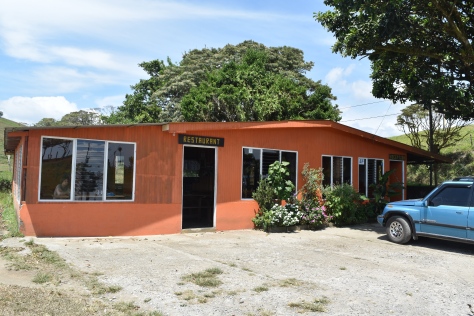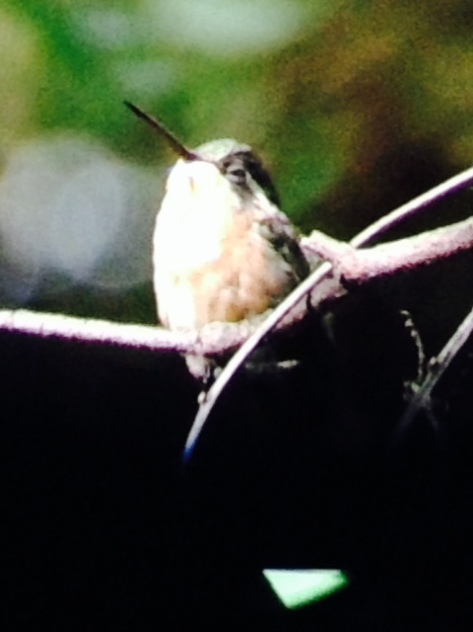Heading to Santa Elena and Monteverde
We say good-bye to the Linda Vista Hotel… and I also say good-bye to my wonderful memories with Ernst that had revived here. With Ursula I drive along the Arenal Lake, come across the flag of Nidwalden or Obwalden decorating a farm and hotel built in the Swiss Chalet style, enjoy a Zimtschnecke and an Apfeltasche at Tom’s German Bakery, fill gasoline “regular” into our car and then tackle the notoriously bad roads to Monteverde. This Quaker settling founded in the fifties tried to stem the tourist flow invading the rain and cloud forests since the early eighties by resisting to having the acccess roads paved, but the tourists come nevertheless. I assume that they stay longer though before tackling the bumpy roads again.
On the way we stop at the restaurant Viento Fresco to eat lunch. Yes, I remember, we have stopped here as well seven years ago. This small restaurant is at a convenient distance from the Arenal.
The Viento Fresco offers excursions to their waterfalls. But we continue our rough forty kilometers to Santa Elena across pastures dotted with cows. We have reserved a room in Cabinas Eddy that now is managed by the son, Freddy, and his mum.
We have chosen this place for its friendliness and good value for money. Immediately we reserve the guide Mauritius for an early morning walk in the cloud forest reserve.
.
Yes, this time we saw the Quetzal in the cloud forest reserve
We take the early public bus at 6:15, arrive at the Reserva Biologica Bosque Nuboso around 6:45 and start our tour with Mauritius shortly after seven.
The cloud forest has grown on the slopes and ridges of the Monteverde mountains, fed by the clouds that rise from the Pacific Ocean and bring rain, even in the dry season. The forest is dense and characterized by the abundance of epiphytes such as bromelia and orchids.
Slowly we follow Mauritius. He fixes his Swarowsky firmly on the ground, directs it to some branches, and we see a green Tucancillo peeping out of a hole in the stem of a tree. This is the smallest Tucan of Costa Rica.
Mauritius shows us more birds hidden in the dense forest: The Tangara Vienticastaña, Saltón Cabecicastaño, Solitario Carinegro and Trogon Ventrinaranjado – like its cousin, the Quetzal, belonging to the order of the Trogoniformes, as Wikipedia explains to me.
The birds are small and far away in the leaves. With my i-phone, Mauritius takes fotos using his Swarowsky, like of this Chispita Volcanera.
Here is a caterpillar that will become a butterfly,…
and here is a venenous snake (called Palm Pitviper). What eyes does Mauritius have to spot the green snake rolled up here? It looks a bit like a sandwich.
A Coati walks on the path and disappears quickly in the bushes. An ardilla or squirrel runs up and down a tree.
But what we look for now, is a Quetzal. We can hear them, but where are they? A colleague guide gives us a hint and, yes, we find the Quetzal. Here it is, also taken through the lens of the Swarowsky using my i-phone.
It is blue with a red-brown breast. It has this long long tail and a crown on the head. Mauritius sings with the bird that replies believing he might be a female Quetzal. We stay here for a long time watching how the bird cleans his wings. Mission completed, was this not what we came to Costa Rica for? Ursula asks jokingly.
To end the walk we visit the Colibri place at the entrance of the park. We spot a Brillante Frentiverde and a Colibri Montañés… “If you are lucky you can see nine species here…”, I hear someone say.
After the walk with Mauritius, we slender through the park on our own. Our target is the “the Ventana”, where we can almost see the Pacific Ocean and the Carribean at the same time… almost, if it were less hazy. This is the view towards the Carribean Sea.
We cross the hanging bridge, see another Tucancillo and soak in more impressions from the dense and multilevel vegetation of the cloud forest. Good for us that it is not raining, but nature would need more rain here.
We take the bus back to Eddy’s to have a siesta and book the night walk with Mauritius.
.
The night walk – full of surprises in the dark
Around six it gets pitch dark in Costa Rica. We are close to the equator. We are a group of six that sets off with Mauritus. He explains that we will walk in a forest that has no bromelias and no orchids. It is a much drier forest than the cloud forest. There are various micro climates around Monteverde/Santa Elena.
Mauritius warns us not to touch the leaves. Because there might be snakes or insects… And to underline, what he means, he shows us some leaves full of wasps. They are sleeping here. They currently have no nest. as they look for a new place. If we touched the leaves, the wasps would wake up and become very angry. On the stem of a tree we find a scorpion. Under UV light it is very bright, under normal light it is just grey, difficult to distinguish from the wood. It is also not recommended to touch the scorpion!
We look at the trees. There are strangular figs that grow from the top of a tree to the bottom, settling their roots and strangling the original tree. Just the fig tree remains. Mauritius lifts up avocados. Well, sort of. They are tiny, just big enough to fit into the beak of the green Tucancillo – its favorite food.
Mauritius finds some sleeping birds. They stand with one foot on a branch hiding under leaves and placing their heads under their wings. We see a thrush (Drossel) sleeping and two whitish birds. The light does not wake them up. “How did you find them?” we ask. Mauritius smiles… these birds always come back here to sleep.
We observe leafcutter ants. The smaller workers carry leaves. The larger soldats protect them. The leaves are fed to a fungus in the anthill. And this fungus then provides the food to the ant brood.
And we also see some mammals. An armadillo with nine belts – Mauritius has heard it run on the ground – well I could not hear its steps. Then an alarm – a colleague guide has spotted a sloth. All night walkers congregate around it. It hangs high up in the trees and moves a bit, as if it had bad dreams. No wonder with all the lights pointing at the poor animal. While walking back, Mauritius points to an Olinga and explains that this animal is similar to a Kinkajou… okay? And both are similar to a Coati. Okay, we know Coatis and that they are related to Rancoons. We watch the Olinga that elegantly runs along branches, also high up in the trees.
While we drive back to our hotels, Mauritius mumbles: ” A sloth on an electrical cable!” He stops the car and lets us out. Right. There is a sloth hanging on a bunch of electric cables and rushing along it – I have never seen a sloth move so fast. Well, the village has cut off the migration path of the sloths, but has created a new “road” for them to “walk” along. It is just a dangerous walk and I do hope that this sloth will not be hurt. I took a foto using my i-phone in the dark, here it is.
As we leave the car and say good-bye to the group and Mauritius, Ursula summarizes: “Das isch witzig gsy” or “this was cute”. Thank you, Mauritius, for this night wildlife experience.








